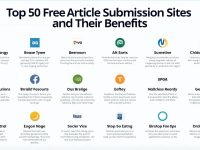
What is SEO?
SEO means Search Engine Optimization. It is a way to help your website appear higher in Google and other search engines. When your site ranks higher, more people will be able to visit it. This traffic is called organic traffic.
If you are new to blogging or digital marketing, you may have heard the word SEO many times. This guide will help you understand what SEO is and how to use Search Engine Optimization effectively.
Why SEO is Important
If you have a website or blog, you need visitors. Without traffic, a website is useless. You can get traffic in many ways:
- From social media
- From paid ads
- From search engines (called organic traffic)
Organic traffic is the best because it is free and long-lasting. To get this traffic, you need to optimize for SEO.
Types of SEO
There are 2 types of SEO:
- Black Hat Search Engine Optimization
This is not the best way to achieve fast results. People use tactics such as keyword stuffing, creating fake backlinks, or clicking on their site. These tricks may work for a short time, but search engines can block your site later. - White Hat Search Engine Optimization
This is the proper and safe way. You follow the rules, write good content, and wait for results. It takes time, but your site stays safe and gets real traffic from Search Engine Optimization efforts.
How to Do SEO
There are two parts of SEO:
- On-Page Search Engine Optimization: Done inside your website
- Off-Page Search Engine Optimization: Done outside your website
If you are a beginner, start with On-Page SEO because it is crucial for SEO success.
On-Page Search Engine Optimization Tips
Page Title
Use your main keyword in the title. Keep it between 60 and 70 characters.
Meta Description
This is a summary of your post. Use your keyword once. Keep it under 160 characters.
Keyword Placement
Use your main keyword in:
- The first 200 words
- Headings and subheadings
- The last paragraph
Keyword Density
Use your keyword 1% to 5% of the time. Don’t overuse it.
Page URL
Keep it concise and include your primary keyword for better Search Engine Optimization.
Website Speed
A fast site gets a better ranking. To speed up your site:
- Use good hosting
- Remove extra plugins
- Compress images
- Use clean templates
Subheadings (H1 to H6)
Use headings with keywords to organize your content for better SEO performance.
Website Design
Use a clean and mobile-friendly design. It helps users and improves Search Engine Optimization.
Outbound Links
Link to other good websites. Make sure they are trusted sites.
Internal Links
Link to your other blog posts. Use 4–5 links per post as part of your Search Engine Optimization strategy.
Image Alt Tags
Add alt text to every image. It helps search engines know what the image is about, boosting SEO.
Image Optimization
Compress your images before uploading. Use tools like compressor.io to improve Search Engine Optimization.
Social Share Buttons
Add share buttons so users can share your post easily to enhance SEO visibility.
Content Length
Write in detail. Long and useful posts rank better in Search Engine Optimization.
Conclusion
Search Engine Optimization takes time, but it works. There is no shortcut. If you follow the proper steps, your website will get more visitors from SEO.
Thanks for reading this Search Engine Optimization guide! If you found it helpful, please share it on social media.


















0 Comments